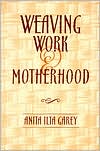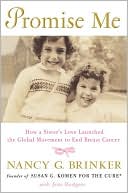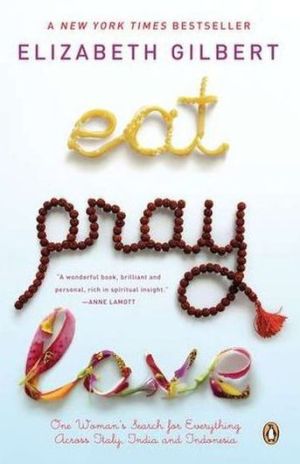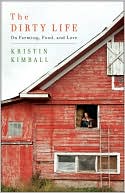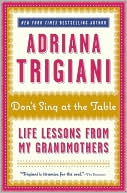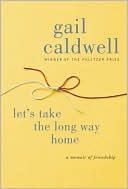Weaving Work and Motherhood
In American culture, the image of balancing work and family life is most often represented in the glossy shot of the executive-track woman balancing cell-phone, laptop, and baby In Weaving Work and Motherhood, Anita IIta Garey focuses not on the corporate executives so frequently represented in American ads and magazines but, rather, on the women in jobs that typify the vast majority of women's employment in the United States.\ A sociologist and work and family expert, Garey situates her...
Search in google:
In American culture, the image of balancing work and family life is most often represented in the glossy shot of the executive-track woman balancing cell-phone, laptop, and baby In Weaving Work and Motherhood, Anita IIta Garey focuses not on the corporate executives so frequently represented in American ads and magazines but, rather, on the women in jobs that typify the vast majority of women's employment in the United States.A sociologist and work and family expert, Garey situates her research in the health service industry. Interviewing a racially and ethnically diverse group of women hospital workers-clerical workers, janitorial workers, nurses, and nurse's aids-Garey analyzes what it means to be at once a mother who is employed and a worker with children.Within the limits of the resources available to them, women integrate their identities as workers and their identities as mothers by valuing their relation to work while simultaneously preserving cultural norms about what it means to be a good mother. Some of these women work non-day shifts in order to have the right blocks of time at home, including, for example, a registered nurse who explains how working the night shift enables her to see her children off to school, greet them when they return, and attend school events in the way she feels "good mothers"should-even if she finds little time for sleep. Moving beyond studies of women, work, and family in terms of structural incompatibilities, Garey challenges images of the exclusively "work-oriented" or exclusively "family-oriented" mother. As women talk about their lives, Garey focuses on the meanings of motherhood and of work that underlie their strategies for integratingemployment and motherhood. She replaces notions of how women "balance" work and family with a better understanding of how women integrate, negotiate, and weave together their identities as both workers and mothers.Breaking new ground in the study of work and family, Weaving Work and Motherhood offers new insights for those interested in sociology, gender and women's J studies, social policy, child care, social welfare, and health care. Booknews Women have always worked, and the notion of combining family and work is not a new one, but Garey (sociology, U. of New Hampshire) emphasizes the possibilities and obstacles faced by women today, particularly in part-time and female-dominated positions. Using in-depth interviews with women working in traditionally female roles in a hospital, she discusses the strategies women use to integrate both family and career, as well as the social solutions necessary to help women better coordinate the two. She concludes that women do not have to choose between employment and family, but rather that they can combine the two successfully. Annotation c. Book News, Inc., Portland, OR (booknews.com)
\ \ \ \ \ Chapter One\ \ \ "Working Mothers"\ \ \ I grew up in the 1950s, but my 1950s was not the one I read about, many years later, in sociology texts, where families were nuclear, fathers were the sole breadwinners, and mothers stayed out of the labor force and were called housewives. And because children assume that the world they know represents the way the world is, my 1950s family was my norm. And in my 1950s, mothers were employed.\ My grandmother, my mother, my aunts, and the woman down the street all held jobs. They weren't always full-time jobs, or year-round jobs, or day jobs (although my grandmother sometimes held two jobs), and they certainly weren't "careers," but the women I saw around me were employed. Everywhere I went I saw employed women: my elementary-school teachers, the receptionist and the assistant in my dentist's office, the nurse at the clinic, the beautician who did my grandmother's hair, the grocery clerks at the A&P, the "cafeteria ladies" at school, bank tellers, the school secretary, the salesclerks at Woolworth's and at the candy store, the ticket-seller at the movie theater, the saleswomen in the clothing department of Sears, the "Avon ladies" who came to the door, and the voices of the telephone operators. I had no doubt that women, including mothers, worked; I would have been surprised to find that they didn't.\ What I've discovered since then is that not all work counts as work in discussions of "working mothers." As a child, I had not yet learned that what counts as real work isfull-time (forty hours or more), day-shift, year-round employment in a defined occupation. I had not yet learned how not to see the employment of large numbers of women, many of them mothers. This disjuncture between my experience of women and employment and what I read about the 1950s family sensitized me to the missing stories in generalizations about families, mothers, and employment.\ The research on which this book is based began from questions and understandings that originated in my own experience of and exposure to mothers who were employed, and in the disjuncture between that experience and the social-science concepts used to describe women's relationship to employment and motherhood.\ \ \ Employed Mothers as Invisible Workers\ \ \ What is the real story about employment and motherhood in the 1950s? It is true that at any one point in time, according to official national statistics, most married women were not in the formal labor force during the 1950s. But most is not all, and some groups of mothers were more likely to be involved than others. Mothers moved rapidly into the labor force over the decade. Only 12 percent of married women with children under the age of six were in the labor force in 1950, but the labor-force participation rate of married women with children between the ages of six and seventeen was just over 28 percent (U.S. Bureau of the Census 1975:134, Series D-63-74). By the end of the decade, 39 percent of married mothers with school-age children were employed, as were almost 19 percent of married mothers with children under the age of six (U.S. Bureau of the Census 1996:400, table 626). If we counted employment in the informal sector or in family-owned businesses as well as in the formal sector, the proportion of "working mothers" would be even greater. My point, however, is not that the proportion of mothers employed in the 1950s was high, but rather that the presentation of nonemployed mothers as normative either has characterized the "working mothers" of the 1950s and later as deviant or has rendered them invisible.\ Often, mothers' employment is also made invisible within their own families. For instance, when I interviewed Ruth, a forty-six-year-old registered nurse, she told me that her mother was a housewife and added, "She was from the old school, she stayed home and raised her kids." In response to follow-up questions, Ruth "remembered" that her mother had been employed part time in a newspaper office when Ruth was in school. This kind of invisibility continues today. In an undergraduate course I taught on work and family intersections, students interviewed their own mothers or grandmothers about their work histories. Rosemary, a college senior, was amazed to "discover" that her mother had been employed when Rosemary was in high school. "I thought all she did was get on my case all the time," she added, clearly puzzled that her mother had had time to hold a job and to be such a presence in Rosemary's life. Several other students were surprised at their own discoveries, learning (or, rather, seeing) for the first time that their mothers and grandmothers had been employed while raising children. This discrepancy between the fact that their mothers were employed and their experience of their mothers as stay-at-home moms intrigued me.\ \ \ "Working Mothers" in the United States: What Kind of Work?\ \ \ Since the 1950s, there has been a steady increase in the proportion of women in the formal labor force. The major part of this increase has been the result of married women entering the labor force, and this has been true across racial-ethnic groups (Amott and Matthaei 1996:304-6). Two dramatic changes have drawn significant attention to the topic of "working mothers": the increase in the percentage who are employed of mothers with children under six years of age (U.S. Bureau of the Census 1990c) and the increase in the percentage of employed mothers not working in home-based employment (Bose 1987; Matthaei 1982:282-83). In 1995, 63.5 percent of married women with children under six and 76.2 percent of married women with only school-age children were in the labor force (U.S. Bureau of the Census 1996:400, table 626).\ Although more than two-thirds (70 percent) of all married mothers with children under the age of eighteen are in the labor force, scholarly and popular attention to the topic of working mothers has been for the most part narrowly focused on the small percentage of those mothers employed in managerial or professional positions. While there are a number of excellent studies of women employed in blue-collar or pink-collar jobs, sociological studies of work and family use primarily a dual-career family model that focuses on elite and restrictive careers, despite the fact that this does not reflect the experiences of most women, particularly those of most married women with children (Benenson 1984). The general image of the "working mother" in popular magazines or in most scholarly discussions of work and family is of the professional or corporate woman, briefcase in hand. The women I saw around me when I was growing up do not fit this image.\ In popular culture, advice books and magazines for employed women with children also presume that women are employed in professional or prestigious, white-collar occupations. The magazine Working Mother, for example, features a mother-of-the-month on the cover of almost every issue, with an accompanying feature article on the mother's "work and family" story. In the five years from 1993 through 1998, the mothers on the cover have held the following occupations: actor, astronaut, attorney, broadcast journalist, college administrator, concert violinist, corporate executive, engineer, entrepreneur, fitness expert, opera director, photographer, professor, and radio producer. Waitresses, salesclerks, secretaries, and nurses are still the invisible working mothers.\ While inroads have been made by women, including women with children, into male-dominated, professional occupations, most employed women are concentrated in particular categories of work. In 1990, more women were employed as secretaries than as any other single occupation (Reskin and Padavic 1994:53). Fifty-two percent of employed women in 1995 were in nonsupervisory positions in sales, service, and secretarial occupations (U.S. Bureau of the Census 1996:405-7, table 637). Of all employed women in 1995, for example, only 0.3 percent were physicians, 0.4 percent were lawyers, and 0.7 percent were college and university professors (U.S. Bureau of the Census 1996:405, table 637). There is a perception that mothers are employed in managerial and professional positions in far larger numbers than is the case, because the majority of employed mothers are missing from cultural images and social analyses of working mothers. In the 1990s, as in the 1950s, critical disjunctures still exist between the experiences of employed women with children and the representations of working mothers in both popular culture and scholarly literature.\ \ \ The Orientation Model of Work and Family\ \ \ Historically, women with children have always been involved in productive labor (Folbre 1991; Jones 1987; Kessler-Harris 1981). For most women, that productive labor took place in their households, and for some women that labor also took place in the households of others. We also know that, with industrialization, most productive labor moved out of households, and many women joined the formal, paid labor force (Kessler-Harris 1982; Matthaei 1982). We know that certain groups of mothers have consistently had higher rates of labor-force participation than the native-born, White population of mothers (Amott and Matthaei 1996; Harley 1990), and we know that the relatively low labor-force participation of White women during the 1950s was an aberration in the trend of women's labor-force participation (Bergmann 1986:19-24; Coontz 1992:155-63). Despite all that we know about changes in the labor-force participation of women in general and of mothers in particular, most discussions of women's employment are embedded in an ahistorical and homogenizing model that rests on concepts of "choice" and "orientation."\ Although there is great variation by race-ethnicity and class in the work experiences of women in the United States, most discussions of women, work, and family are embedded in a conceptual frame that I have termed the orientation model of work and family. For women in the United States, employment and family have been portrayed dichotomously—and women are described as being either "work oriented" or "family oriented." These concepts are not similarly linked for men. To be a "family man" not only includes, but necessitates, providing economically for one's family (Bernard 1981; Coltrane 1996:4; Townsend 1992), and while some men may be referred to as workaholics, this term is reserved for those perceived to be extreme in the time they give to their employment. For men, employment and family are not portrayed as inevitably detracting from one another. For women, work and family are represented as oppositional arenas that have a zero-sum relationship. In this representation, the more a woman is said to be oriented to her work (employment), the less she is seen as oriented to her family. Regardless of the experience of work and family for individual women or within particular groups of women, the dominant cultural portrayal of work and family for women in the United States classifies women as either work oriented or family oriented.\ People's everyday reactions to mothers who are employed reflect this representation, as demonstrated by research conducted by Claire Etaugh and Gina Study. Etaugh and Study asked 192 people to rate personality and performance attributes of hypothetical mothers who differed only in terms of whether the woman was married or divorced, had either a one-year-old or an eleven-year-old child, and was either employed or nonemployed. The findings revealed that mothers described as employed "were seen as simultaneously less dedicated to their families and more dedicated to their careers, as well as more selfish and less sensitive to the needs of others" (Etaugh and Study 1989:67). The inability to conceptualize for women the integration of a commitment to work and a commitment to family means that employed women with children are seen as less than fully committed mothers. This has not been true for perceptions about fathers. For men, employment is perceived as an integral part of what fathers do, as fathers, to support their children. Thus parenthood and employment are gendered institutions; that is, the systems of social relations embedded in these social institutions are organized differently for men and women and perpetuate gender differences.\ The orientation model of work and family, which has framed most sociological analyses of work and family, fits into a larger ideological framework of separate spheres. The ideology of separate spheres divides the social world into two mutually exclusive areas: the public realm of economic and civic life and the private realm of domestic life. This ideology relegates women to the domestic sphere and men to the public arena (Welter 1973). It is not surprising that this ideology emerged in England and the United States in the wake of the industrial revolution, when production moved out of households and into factories. With respect to family life, this meant that men, as fathers, were expected to go outside the home to work in the public world, while women, as mothers, were expected to stay home and be in charge of the domestic world of home and children (Parsons and Bales 1955; Rothman 1978; Skolnick 1991:30-33). Phrases like "breadwinner father" and "stay-at-home mom" epitomize the ideology of separate spheres. But when mothers are employed, the model cannot accommodate them very well; thus employed mothers are described in terms of divided relationships to arenas that are seen as separate and oppositional.\ In the same way, conceptualizing women's involvement with employment and family in terms of an orientation obscures the integration and connectedness of that involvement. For example, women who postpone having children until they complete their education, or are established in their occupation, or have saved a certain amount of money are acting in ways connected to both family and employment considerations, but they would be categorized as work oriented in an orientation model. Women who work non-day shifts or part-time schedules are also attempting to mesh work and family, but anyone using the orientation model would categorize these women as family oriented. The orientation model of work and family is primarily a behaviorist model that categorizes observable behavior, including what people say, without considering the meaning and context of the behavior to the actors.\ Even feminist sociologists who write eloquently about the need and capacity of women to combine motherhood and employment use descriptive frameworks that are embedded in an orientation model. Kathleen Gerson's book, Hard Choices (1985), provides one such example. Although she makes the case for the individual's capacity to integrate work and family (200), she nevertheless categorizes the women she interviewed on the basis of orientations. Gerson describes these women as either "work-committed women," "domestically oriented women," or "reluctant mothers." Although the latter category refers to the women "who chose to combine committed work with parenthood" (158), they are described in terms of their disinclination to integrate children into lives already oriented to the workplace. Their decisions to have children, Gerson notes, were based on the fear that not having children would ultimately be worse than having them. Although Gerson's point is that women can and do change orientations, my point is that the concept of orientation obscures the integration and connectedness of employment and motherhood in women's lives.\ Similarly, in her book on working women, Mary Ann Mason, a professor of law and social welfare, categorizes women workers as either "women who live to work" or "women who work to live" (Mason 1988). And in a two-stage survey about the employment and family plans of women college students (Granrose and Kaplan 1996), the researchers grouped women into two sets of oppositional categories: Women whose decisions were consistent with their original plans were labeled either Careerists or Homemakers; women whose decisions did not correspond to their original plans were called either Breadwinners or Nesters. In each set, women were typed as oriented toward either employment or family—there was no integrative set.\ The move from an analysis of structural incompatibilities between employment and motherhood to a typology of women with orientations to either work or family is a problem common to studies of women and employment. It is one thing to say that the workplace is organized in ways that conflict with the way family life is socially organized and another thing to say that individual women are thus oriented toward one or the other of these social structures.\ It is possible, of course, to find women who are completely immersed in their children to the exclusion of any other interests and who therefore fit the description of "family oriented." And it is possible to find women who are exclusively focused on their work lives. The problem is that the orientation model implicitly assumes a bimodal frequency distribution of mothers into these two categories. If what we have is really a normal distribution, with the categories "work oriented" and "family oriented" at the tails of the distribution, then the area of greatest concentration, in the middle, is also the area that has been most neglected in scholarly work: employed women with children who are interweaving work and family in their lives.\ Analyses that are cast in terms of an orientation model are firmly connected to the formulation of research questions. Gerson's research question, for example, was how women "choose between work and family commitments" (Gerson 1985:2). "Choosing between" implies that choosing both is not an option. At present, we lack a model, framework, metaphor, or language that adequately describes women's lives as both workers and mothers. We need a way of understanding what it means to choose both, and we need a way of thinking about women's employment that doesn't presume a zero-sum relationship between women's commitments to employment and to their families.\ \ \ "Working Mothers": Making Sense of Oppositional Images\ \ \ The way in which work and family are conceptualized in the dominant culture in the United States in the late twentieth century helps explain the puzzle of why people often did not know that their mothers were employed or, if they knew, why they still thought of them as stay-at-home moms. Embedded in the concepts "work oriented" and "family oriented" are cultural norms about what it means to be a good worker and a good mother. In spite of their oppositional relationship, these concepts are brought together in the term "working mother."\ In this book I ask, What does it mean to be a working mother, given that work and family are portrayed as conflicting with each other? How do employed women with children think about their lives and about the ways in which work and motherhood fit into those lives? What does it mean to be a worker with children—and a mother who works?\ Basically, a working mother is an employed woman who is also responsible for and in a parental relationship with one or more children. But clearly more is contained in the term "working mother" than this simple definition. We don't, for example, have an equivalent term, "working father," for men—even though most men are employed and most men have or will have children. "Working mother" is a conceptual category meant to encompass the relationship for women between being employed and being a parent, but since that relationship is presented as oppositional, it is a conceptual category that often creates more confusion than clarity.\ When I interviewed Danielle, a thirty-six-year-old, Euro-American, full-time clerical worker and the mother of a five-year-old child, I told her that I was interested in what being a working mother meant to women who were employed and who were mothers. Danielle's response illustrates the confusion that can occur in the attempt to get at the meaning of "working mother":\ \ \ I don't think that means anything. Not to me. I have a real problem with that phrase, because it implies that women who are at home don't work; it also—men who are parents are never called working fathers [exasperated laugh]. And I guess, from that, men who are parents work and a lot of women who are parents work and that's just, that's what is. And it's just this nice phrase that can be attached to one group of those parents—but anyway, I'm trying to think if I would describe myself as a working mother. I don't think I would! I think I'd have to take a few sentences to describe myself. I mean that's just too easy a phrase ... and it doesn't have a lot of meaning.\ \ \ This employed mother finds that the term "working mother" doesn't fit her experience; it is a gendered and asymmetrical conceptual category. She wonders what it says about her relationship to work if men are not called working fathers and what it says about the work of mothering if the term "mothers" is qualified by "working" when mothers are employed. She does not, however, find available alternative terms or concepts that simultaneously capture her identity as a mother and an employed person; as she says, "I think I'd have to take a few sentences to describe myself."\ Why does Danielle have so much trouble using the term "working mother" or finding terms that would articulate her identity as both a worker and a mother? I suggest that the difficulty stems from the fact that the term "working mother" juxtaposes two words with antithetical cultural images: worker/mother; provider/homemaker; public/private. The problem Danielle faces is twofold. First, the term "working mother" does not adequately convey her experience, and second, the terms that would describe her experience do not yet exist in our daily shared vocabulary. This problem is an example of what Dorothy Smith (1987) describes as a disjuncture or schism between the way in which women experience the world and the concepts constructed by "experts" to explain that world.\ Concepts are intended to direct or focus attention, but concepts can also work to redirect attention and desensitize perception (Blumer 1969:168; Hughes 1971:339; Smith 1987:61-64). The very construction of the term "working mother" points our attention in particular directions: "mother" is a noun, and "working" modifies "mother." We do not say "mothering worker," which conjures up an image of a nurturant employee; nor do we say "mother worker," which sounds more like a job category for nannies. Clearly, when one goes from being a "working woman" to being a "working mother," it is "mother" that, linguistically, stands for the essential self. It is the mother who works, not the worker who has children. It is the mother who must fit into the workplace, not the workplace that must adjust to the needs of workers with children. When workers do adjust their work to their family responsibilities, their actions are interpreted as the actions of their selves as mothers, not of their selves as workers. It is "mother" that is an identity, "working" that is an activity; it is "mother" that is being, "working" that is doing.\ On the one hand, when we conceptualize mothers as being rather than doing, the work of mothering is hidden. I mean not only the work of maintaining children, although that is certainly a part of the work mothers do, but also all of the ways of acting in relation to one's children that constitute not only the expected norm, but also the actual practice of a great many people. On the other hand, by directing our attention to working as an activity, we divert our attention away from what it means to women, including mothers, to be workers. Everett Hughes (1971) notes that "a man's work is one of the more important parts of his social identity, of his self, indeed of his fate, in the one life he has to live" (339). Whether Hughes meant men or humankind, it has been shown that work is also an important part of the social identity or being of women, including mothers (Bennett and Alexander 1987; Ferree 1976; Komarovsky 1967 [1962]). Therefore, instead of the orientation model of work and family, we need a framework that makes sense of both the experiences of employed women with children and the experience of being an employed woman with children.\ \ \ Weaving: An Alternative Framework\ \ \ More than twenty years ago, Jessie Bernard (1975) stated that much of the research on women's roles as workers and as mothers suffered from what she referred to as "the Pickwick fallacy": "When Mr. Pickwick had to write a paper on Chinese metaphysics, he read everything in the Britannica on China and everything on metaphysics. He was then well prepared to write his paper on Chinese metaphysics. A growing research literature tells us about women in the labor force; another tells us about women in the family. Just as we need policies that help women themselves integrate their two roles, we need an integrated research approach that will help us see the lives of women as unitary wholes" (242). The research on which this book is based represents precisely such an attempt. This study focuses on working mothers simultaneously as mothers and as workers. By focusing on working mothers as mothers and not simply as women who have responsibility for child care, I ask what it means to be a mother and how mothers enact these meanings in the structure of their daily lives and in their presentations of self. By focusing on mothers as workers and not simply as women who have jobs, I ask what it means to be employed and how women with children negotiate the meaning of work in their lives. Thus this is also a study of meaning and of the ways in which women negotiate strategies of being that are meant to reconcile their identities as mothers and as workers.\ The literature on women in the labor force has added greatly to our understanding of women and work, but there has been little research that attempts to answer Bernard's call for an integrated vision of the lives of women who are mothers and workers "as unitary wholes." While sometimes mentioning the impact of women's family roles, the general literature on women and employment has seldom concentrated on women workers' family relationships. Those studies that do focus on this (see, for example, Hertz 1986; Hochschild and Machung 1989; Rosen 1987; Zavella 1987) have directed attention to the negotiation of spousal relations and housework rather than to the work of mothering or the meanings of being a "working mother." In general, motherhood has not been a constitutive part of most studies on women and work.\ Similarly, the burgeoning literature on the institution, experience, meaning, and social reproduction of motherhood has not focused on mothers as mothers in the labor force. Martha McMahon's discussion of the evolution of the research for her book Engendering Motherhood (1995) provides an example of the way in which women's identities as mothers and as workers are not examined together. McMahon explains that she originally planned to study the meanings of both motherhood and employment in women's lives but ended up focusing solely on motherhood (4). While her book is an insightful analysis of "identity transformations through motherhood," it leaves unaddressed the problem of unification that Bernard set for us.\ Most of the existing research on the way in which employed women with children mediate work and family has focused on the household division of labor, relations between spouses, effects of mother's employment on children, and measures of role strain or role conflict. In these studies, the problem has been conceptualized as one of conflict, and the meaning of motherhood has been reduced to role-specific tasks, such as the provision of child care. While it is absolutely necessary to examine the conflicts that employed women with children face as workers and as mothers, this should not be the only way of analyzing women's relationship to employment and motherhood. An excellent ethnographic study that nevertheless incorporates this view of motherhood and mothering is Sunbelt Working Mothers (Lamphere et al. 1993). The authors write: "At home, mediating the contradiction between their roles as mothers, wives, and workers involves replacing their reproductive labor. First and foremost this means finding someone to care for their children while they are at work" (20, emphasis added). The practicalities of providing child care are a central issue for employed women with children, but I found that when women talked about child care they also revealed deeply rooted concerns about their identities as mothers and expressed how much they valued their identities as workers.\ \ \ I suggest that we use the metaphor of weaving as a way to look at the lives of employed women with children. Weaving is both a process (an activity—to weave something) and a product (an object—a weaving, something constituted from available materials), and I use the image in both senses. As a process, weaving is a conscious, creative act. It requires not only vision and planning, but also the ability to improvise when materials are scarce, to vary color and texture in response to available resources, to change direction in design, and to splice new yarn. As a product, a weaving reveals both grand patterns and minor designs; it reveals the connections between pattern changes and how what has come before is linked to what follows; and it reveals the richness or thinness of the materials used.\ The metaphor of weaving illuminates the meaning that the women I interviewed gave to their life stories by capturing the interconnectedness of work and family within women's lives. In her book Composing a Life, Mary Catherine Bateson (1989) compares the ways in which people design and fashion their lives to throwing a pot or building a house. Bateson suggests, too, that a life story is a composition in which the musical note, the brush stroke, or the written word is not simply a step toward a finished product but also an elemental part of the score, the painting, or the manuscript. I use a modified "composite" approach in my research on employed women with children. I do not look at every aspect of their lives, but I focus on two major areas: their lives as workers and their lives as mothers. This leaves out large areas that comprise a person's life: sexuality, religion, politics, community, marriage, and friendships. But as a central metaphor, weaving incorporates Bateson's sense of "composing a life" and runs counter to a model in which work and family, for women, are seen as inherently competing claims. The women I interviewed are each trying to weave a life pattern in which employment and motherhood are integral parts of the fabric.\ \ \ METHOD\ \ \ Because I wanted to talk to women whose employment resembled the employment of the majority of women in this country, I located my study in the health service employment sector and interviewed women hospital workers. In 1995, the health service industry employed 14.8 percent of all employed women (U.S. Bureau of the Census 1996:410, table 641). This segment of the labor force includes the occupations held by the women I interviewed: registered nurses, licensed practical nurses, nurses' aides, secretaries, typists, clerks, and janitorial service workers. The group of women I interviewed is not intended to be representative of all employed women with children, but occupations within the hospital are typical of the kinds of female-dominated occupations that account for most women's employment in the United States.\ Because hospitals operate twenty-four hours a day, seven days a week, they are work sites with a wide variety of work schedules: shift work, a range of part-time possibilities, full-time work, and weekend as well as weekday schedules. As I illustrate in this book, these scheduling options provide some mothers with the means to be the kind of "working mothers" they aim to be, while at other times or for other mothers a hospital's scheduling requirements constrain their abilities to fulfill those aims. The hospital setting takes us closer than many other work sites could to the kinds of employment and the range of work schedules experienced by the majority of employed women.\ I interviewed thirty-seven women hospital workers who had children. Most of the interviews were conducted between 1991 and 1992, and interviewees were selected primarily from two medical-surgical wards of a large private hospital in California. I designed this study from an ethnographic perspective, beginning with a group that existed as a group in a particular place at a particular time. While the people I interviewed shared a work setting, they occupied different positions within that setting. Of the thirty-seven mothers I interviewed, twenty were nurses, two were nurses' aides, three were nursing directors, five were clerical workers, four were janitorial workers, two were administrators, and one was a union official who had been a hospital ward clerk for twenty-four years. A diversity of qualifications and resources exists within, as well as between, each of these occupational areas. Two-thirds (twenty-five) of these women had full-time positions, and one-third (twelve) held part-time positions. Twenty-two of them worked a day shift, and the remaining fifteen worked evenings (five), nights (seven), or a combination of shifts (three). Most of those in part-time positions worked the day shift.\ The women ranged in age from twenty-seven to sixty years; four were in their twenties, twelve were in their thirties, fifteen were in their forties, five were in their fifties, and one was sixty. Twenty-four of the mothers were married at the time of the interview, six were divorced, two were separated from their husbands, and five were single and had never been married. One of the divorced women and one of the single women were living with partners, which meant that twenty-six of the mothers were living with a spouse or partner and eleven were single parents. The number of children born to each woman ranged from one to six. More than half of the women (nineteen) had two children; eight women had one child, and four of these indicated that they planned to have at least one more. At the time of the interviews, eighteen of the mothers had a child under the age of six years; twelve mothers had a youngest child between the ages of six and eighteen, and in seven cases the youngest child was over eighteen years old.\ The group of women I interviewed is racially and ethnically diverse, but ethnicity and race are by no means straightforward categories (Montagu 1963 [1945]; Montagu 1964; Waters 1990). I asked people how they identified their race-ethnicity, and I categorized the women on the basis of their answers. When I am referring to individual women, I follow Amott and Matthaei's (1996) use of terms that denote racial-ethnic group origins, such as African American or Euro-American. When I am talking about a social category, I have used terms such as Black, White, or Latino. In grouping my interviewees into categories, I placed women who answered the race/ethnicity question with "White," "Caucasian," or terms such as "German" or "Swedish" in the social category "White." I have included two Jewish women in this category, although when referring to them individually, I refer to them as Jewish American. I have used the terms Mexican American and Chicana interchangeably. Two of the women identified themselves as Mexican American, and one identified herself as Chicana. The Filipinas I interviewed were all immigrants, but some had immigrated with their families of origin when they were children and had attended school in the United States, while others had immigrated as young adults. Many Filipinas qualified for immigration because they had training and skills that the U.S. government classified as needed; a nursing degree was one such qualification and accounts for the relatively high proportion of Filipinas working in California hospitals. Filipinas have "eight times their labor force share of nursing jobs" (Amott and Matthaei 1991:246).\ I interviewed sixteen Black women, twelve White women, five Filipina immigrant women, three Mexican-American women, and one Chinese-American woman. I identify the race-ethnicity of each woman I interviewed in my discussion of individual women, but race-ethnicity is not treated as an a priori category of comparison. This was also my approach to differences in resources, occupation, age, and marital status.\ Research based on interviews with a group that is so demographically diverse raises problems for many sociologists, who argue firstly that there are too many variables for the size of the group, thus making comparison and analysis impossible, and secondly that the experiences of people belonging to different racial and ethnic categories are so different that studies need to be limited to one group or to the comparison of specific groups. My response to the first problem is that this study is not a comparison of categories; rather, it is a study of an actual group of workers in a particular place at a particular time—and the diversity of the group is represented in the interviews. My response to the second problem is that the question of difference is a question and should not be used as a way of eliminating people from the group being studied (for example, the group "women hospital workers" or the group "working mothers")because they don't share some other characteristics (such as ethnicity or age). Another problem with limiting the group studied in order to control for difference is that findings of difference are built into the research design (Fausto-Sterling 1992).\ My study of employed mothers on two wards of a hospital represents that group in its diversity. The approach I am using has been referred to by Barrie Thorne (1993} as "starting with the whole." Thorne writes, "To move our research wagons out of the dualistic rut, we can, first of all, try to start with a sense of the whole rather than with an assumption of gender as separation and difference. If we begin by assuming different cultures, separate spheres, or contrastive differences, we will also end with a sharp sense of dichotomy rather than attending to multiple differences and sources of commonality" (108, emphasis in original). Thorne is addressing research on gender, but her argument is relevant for any divisions based on assumed differences. We must not presume that the social processes being studied will differ along predetermined lines such as class, race, or age—although those findings may emerge from the research.\ In-depth, open-ended interviewing allows me to study the meanings people give to their actions. It is also a way of hearing, and making heard, the voice of the person interviewed, in this case the voices of employed women with children. In contrast to research that examines women's experience of employment, career, or vocation in terms of the existence and effects of structural incompatibilities between work and family responsibilities, my focus on the experiences of employed women with children is aimed at understanding what it means to be a worker with children and a mother at work. To examine the lived experience of employed mothers and to focus on the meanings that experience has for them is not to place the researcher's analysis of that experience in the hands of her interviewees. The experiences of employed women with children constituted the beginning of the research, and those experiences pointed me in particular directions, often ones that otherwise might not have been evident. The sociologist, however, is the one who attempts to make sense of it all by illuminating connections between individual experience and social relations and thus deepening our understanding of the social world.\ The women I interviewed all gave generously of their time, thoughts, and feelings about being workers and mothers. In the chapters that follow, I have tried to do justice to their stories, to fairly represent their voices, and to bring a sociological imagination to my analysis.
Acknowledgments1"Working Mothers"12Strategies of Being203"Calling the Shots": Voluntary Part-Time Workers564"Putting Your Feet in the Door": Involuntary Part-Time Workers885Motherhood on the Night Shift1086Nine to Five: A Collection of Days1407Sequencing: Patterns over the Life Course1658Conclusion191Notes203References219Index231
\ BooknewsWomen have always worked, and the notion of combining family and work is not a new one, but Garey (sociology, U. of New Hampshire) emphasizes the possibilities and obstacles faced by women today, particularly in part-time and female-dominated positions. Using in-depth interviews with women working in traditionally female roles in a hospital, she discusses the strategies women use to integrate both family and career, as well as the social solutions necessary to help women better coordinate the two. She concludes that women do not have to choose between employment and family, but rather that they can combine the two successfully. Annotation c. Book News, Inc., Portland, OR (booknews.com)\ \
